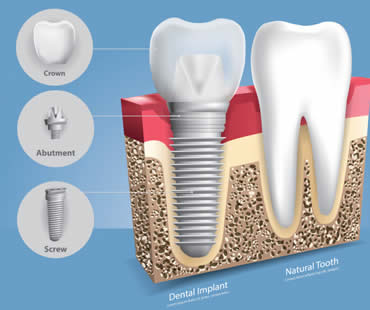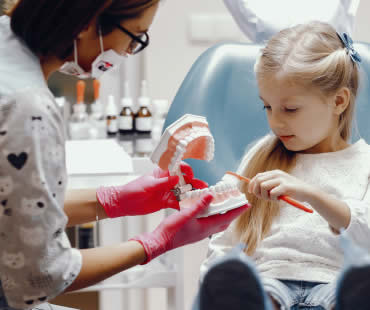
Jan 14, 2022 | Dental Topics 3, Implant Dentistry, Blog
Restoring a missing tooth is not as unnatural as you might think with the help of dental implants. These restorations have transformed the ability of dentists to make your smile complete and fully functional without the worries of cumbersome dentures or bridges.
Dental implants involve surgically placing a titanium rod into the jaw bone, which will then fuse with the bone to become a part of your body. A trusted, experienced dentist or oral surgeon is the best professional for this procedure. The implant provides a stable and secure base for a replacement tooth which is later placed on top of the rod.
Most people with missing teeth are candidates for dental implants, although your dentist will perform an examination to make sure. Healthy gums and ample strong bones are required for a successful dental implant treatment.
There are two main types of dental implants. Subperiosteal is designed for patients with a shallow jaw bone that does not allow for rebuilding, so these implants are placed under the gums. Endosteal is for patients with a thick jaw bone, which is ideal for the implant being placed into the jaw bone using plates, screws and cylinders for support. Your dentist will advise which type of implants are best for you.
Once the implant surgery is performed, the area will be allowed to heal for up to a couple of months so that the artificial tooth or crown placed on top will be able to successfully complete the procedure. Once the entire treatment is finished, you’ll have a fully functional, comfortable and secure new tooth and root.
No special maintenance is required with dental implants. Normal brushing and flossing is recommended, as well as regular dental checkups to guarantee good oral health. Implants are made to last a lifetime with proper oral care. With this advanced treatment that dentistry offers today, you can expect a worry-free restoration that gives you back your smile.
Our dental office is located in Conyers

Sep 28, 2023 | Dental Topics 3, Family Dentistry, Blog
Dentists recommend seeing children for the first time when they have begun to cut teeth, by the time they have celebrated a first birthday. A first visit is primarily about allowing a child to get comfortable in the dentist’s chair and about educating you, the parent, on how to care for your child’s baby teeth. Most children who visit at this age will not remember the visit, but it will lay the foundation for positive experiences in the dental chair in the future.
Once children reach the approximate age of 5, they will have their first set of X-rays taken. The family dentist will review them to look for cavities between the teeth and to check proper development of dormant permanent teeth.
As children age, between 6 and 12 years, they will lose their baby teeth and permanent teeth will begin to erupt. At this time, your family dentist may recommend a tooth sealant. This plastic resin bonds to the “flat” chewing surface of a tooth, protecting it from debris and decay in the crevices.
Your family dentist may also give your child an orthodontic evaluation. Most pediatric patients begin orthodontics once all of their permanent teeth have erupted; however, some patients benefit from staged orthodontics and can begin treatment much sooner.
If your child has been seeing a dentist since infancy, introducing the child to the dentist isn’t an issue; your child already knows and trusts your family dentist. If you are bringing your child to the dentist for the first time as a toddler or kindergarten student, you should plan to spend some time talking about what to expect.
Many times, having parents sit in the dental chair and then hold their child on their laps is very comforting to the patient. Your family dentist has experience in dealing with fearful or anxious children and will know what to do in each case. Often, videos or music are employed to relax young patients.
You can trust your family dentist with each member of your family, no matter what the age. Talk to your family dentist today with any questions you may have about your child’s first dental appointment.
Our dental office is located in Conyers

Jul 11, 2024 | Dental Topics 3, Family Dentistry, Blog
Your family dentist can perform all of the services offered by both a pediatric and an adult dentist, only for your whole family. Some of the most popular options are cosmetic or restorative procedures, correcting such issues as discolored teeth, crooked or misaligned teeth, unsightly metal fillings, crowded or rotated teeth, short or small teeth, or missing teeth or spaces between teeth.
Family members who have had their permanent teeth fully descend are eligible candidates for many cosmetic procedures such as whitening. Have your young person consult with your family dentist before trying any at-home products; immature adult teeth can turn splotchy or the gums can become irritated if at-home whitening products are used incorrectly or for too long. Because tooth discoloration can be a sign of a more serious dental issue, it is important to talk to your family dentist before moving forward with any treatment.
Your family dentist can help you with products such as dental veneers. Don’t suffer with tooth gaps, unsightly stained teeth, or crooked or badly shaped teeth. Veneers are thin layers of tooth-colored material that are placed on top of your teeth and that can correct many mistakes in your natural smile. Veneers can be used to change the color or shape of a single tooth or to spruce up an entire smile.
Talk to your family dentist about replacing your unattractive metal fillings with tooth-colored materials. You don’t have to tolerate a silver smile when you can turn to your family dentist for all-white fillings. Your smile will be far more natural and beautiful than before.
If you are missing a tooth, or are in need of a root canal procedure, talk to your dentist about your choice of crowns and bridges. A crown can save a tooth from total decay, protecting it and giving it a longer life. A bridge can keep you able to bite and chew properly, and can help maintain the shape of your face while preventing other teeth from misaligning.
Your family dentistry practice can help you make all of the decisions you need to make regarding your and your family’s dental health and appearance.
If you live in the Conyers area contact us today

Mar 27, 2025 | Dental Topics 3, Family Dentistry, Blog
Your family dentist can perform all of the services offered by both a pediatric and an adult dentist, only for your whole family. Some of the most popular options are cosmetic or restorative procedures, correcting such issues as discolored teeth, crooked or misaligned teeth, unsightly metal fillings, crowded or rotated teeth, short or small teeth, or missing teeth or spaces between teeth.
Family members who have had their permanent teeth fully descend are eligible candidates for many cosmetic procedures such as whitening. Have your young person consult with your family dentist before trying any at-home products; immature adult teeth can turn splotchy or the gums can become irritated if at-home whitening products are used incorrectly or for too long. Because tooth discoloration can be a sign of a more serious dental issue, it is important to talk to your family dentist before moving forward with any treatment.
Your family dentist can help you with products such as dental veneers. Don’t suffer with tooth gaps, unsightly stained teeth, or crooked or badly shaped teeth. Veneers are thin layers of tooth-colored material that are placed on top of your teeth and that can correct many mistakes in your natural smile. Veneers can be used to change the color or shape of a single tooth or to spruce up an entire smile.
Talk to your family dentist about replacing your unattractive metal fillings with tooth-colored materials. You don’t have to tolerate a silver smile when you can turn to your family dentist for all-white fillings. Your smile will be far more natural and beautiful than before.
If you are missing a tooth, or are in need of a root canal procedure, talk to your dentist about your choice of crowns and bridges. A crown can save a tooth from total decay, protecting it and giving it a longer life. A bridge can keep you able to bite and chew properly, and can help maintain the shape of your face while preventing other teeth from misaligning.
Your family dentistry practice can help you make all of the decisions you need to make regarding your and your family’s dental health and appearance.
We look forward to seeing you in our Conyers dental office

Feb 8, 2024 | Dental Topics 3, Family Dentistry, Blog
Every member of your family requires and deserves good oral health care. From the youngest to the oldest, each person should visit the dentist regularly. This is where a family dentist comes into your life. Family dentists treat all ages and a wide variety of conditions, providing your whole family with the specific treatments they need to achieve healthy, winning smiles.
Not every family dentist is the same. Because it should be a long-term relationship established with your family, make sure you choose the right one who meets all of your needs. Look for a practice with convenient hours and location, a clean and comfortable setting for your care, and the credentials for all aspects of your treatment.
Family dentists are focused on the hygiene and health of your smile. This includes thorough examinations, regular cleanings, fluoride treatments, gum disease therapy, cavity diagnosis and treatment, and even orthodontics.
The great thing about family dentistry is that it addresses dental health for every stage of life. Children have different concerns than their parents and their grandparents. Skilled family dentists provide complete oral care from baby teeth to permanent teeth to restorations for seniors.
Another qualification of family dentists is to recognize and handle dental fears in patients of all ages. Children may be afraid of the unfamiliar environment and sometimes scary equipment, so family dentists are trained to ease their fears through kindness and gentleness. Many of these specialists offer distractions for young patients like videos, music and books. It’s a goal of family dentistry to help children develop a lifelong positive attitude toward dental treatment. Kids aren’t the only patients with dental anxiety though, so family dentists also are able to address fears in adults and offer ways to increase their comfort level.
No matter the ages of your family members or their oral conditions, family dentists are qualified to treat the varying needs with skill and confidence.
Our dental office is located in Conyers

Feb 7, 2020 | Dental Topics 2, Oral Surgery, Blog
Wisdom teeth are the third set of molars and the last adult teeth to erupt into the mouth. Most people have four wisdom teeth, two on the bottom and two on top. Many people do not have enough room for these molars to emerge completely, causing them to become impacted in the gum. Impacted wisdom teeth are difficult to clean, making them more susceptible to decay and disease. Other dental problems caused by impacted wisdom teeth include pain, damage to surrounding teeth, and bite alignment issues. For these reasons, your dentist may recommend having the impacted teeth removed to prevent future problems.
Surgery to extract an impacted wisdom tooth or set of wisdom teeth is usually an outpatient procedure done in your dentist or oral surgeon’s office. If the tooth or surrounding area are deemed to have an infection prior to the procedure, surgery will be delayed, and your dental professional will likely prescribe antibiotics to help heal the area.
On the day of surgery, local anesthesia will be administered to numb the area where the extracted tooth will be removed. Depending on the severity of your case, your dentist or oral surgeon may also utilize a general anesthetic.
Once the anesthesia has taken effect, an incision will be made to open up the gum and any bone blocking the tooth will be removed. Your dentist or surgeon will then separate the tissue connecting the bone to the tooth and extract the tooth. Some teeth are too large to remove in one piece, in which case your surgeon will cut the tooth into smaller pieces to make it easier to remove. Finally, the incision is closed with stitches and packed with gauze to help alleviate bleeding.
Long-term complications from impacted wisdom tooth surgery are rare. To ensure a successful recovery from this or any oral surgery, be sure to follow all aftercare instructions provided by your dentist or oral surgeon.
Schedule your appointment at our Conyers dental office








